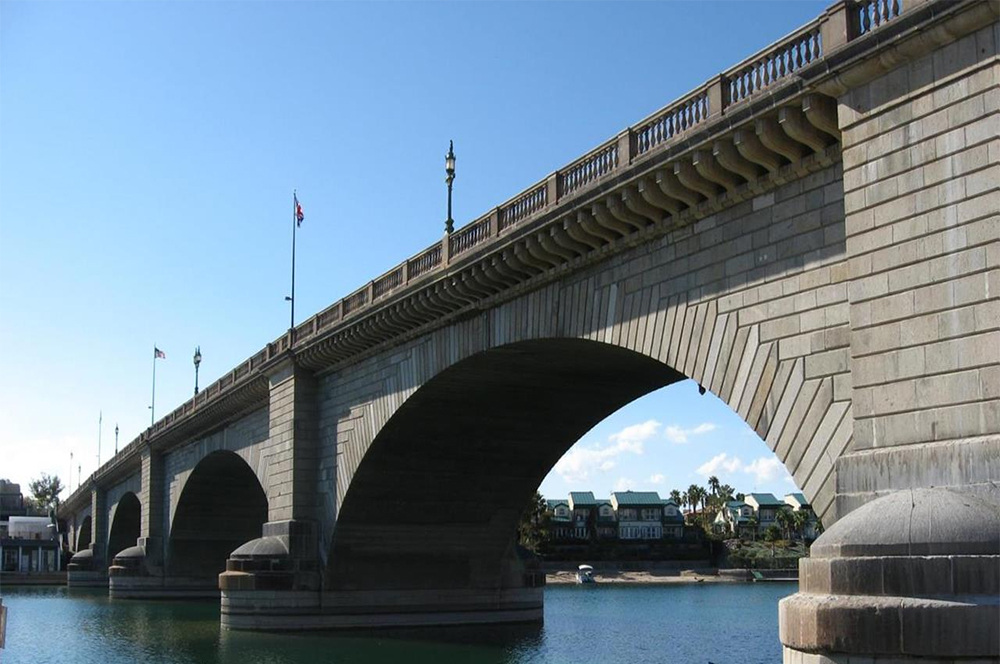A gregarious public relations man named Ivan Luckin brought a rather radical idea to his colleagues at a City of London committee meeting in 1966: He was looking to sell the deteriorating London Bridge — for a whopping million pounds. One city official retorted, “Mr. Luckin, do you really believe someone would pay that sum for a heap of stones?”
The someone turned out to be Robert P. McCulloch, an American industrialist who made his name in chain saw manufacturing. His eponymous oil company had bought 26 square miles of desert in remote western Arizona, along the Colorado River bordering California, with a plan to create a paradise. But McCulloch needed a hook, and that’s how the old joke, “I’ve got a bridge to sell you,” came true for roughly 1 million pounds.
The name is iconic — mentioned repeatedly in literature and the subject of a well-known nursery rhyme — but the London Bridge that was falling down in the 1960s was hardly an artifact. It was built in 1831 to replace the famous 12th-century structure, which for centuries had been adorned with the severed heads of traitors to the British crown, like William Wallace. But a 19th-century stone span built for horses and buggies was quickly rendered obsolete by trains and cars. So by the seismic ’60s, it was slowly sinking into the Thames River at a rate of an inch every eight years. With a replacement sorely needed, it seemed like the aging structure was due for the same fate as the Euston Arch — which had been removed from a London train station in a renovation and dumped in the River Lea just a couple years earlier.
A RUMOR STARTED THAT THE AMERICANS THOUGHT THEY WERE BUYING THE POSTCARD-PERFECT TOWER BRIDGE.
Enter Luckin, a former newspaperman turned PR mover and shaker. He figured America would be a good fit, and his dream had precedent. St. Mary of Aldermanbury church, famously bombed out during the World War II Blitz, had been shipped to Missouri. The RMS Queen Mary ocean liner relocated to Long Beach, California, around the same time, in 1967. Plus, the British capital had a sexy reputation in those days as “Swinging London.”
In trying to build buzz around the sale, Luckin talked up the bridge as representing 2,000 years of history, going back to the Romans. He produced a slick brochure and solicited bids. The winner, announced in April 1968, was McCulloch, who a little more than doubled the cost to dismantle, move and rebuild the bridge: $2,460,000 — just over a million pounds — or more than $17 million today.
The bridge was dismantled, shipped to California and trucked down to Arizona, where the stones were reassembled in a massive undertaking spearheaded by C.V. Wood Jr., a developer whose claim to fame was planning the original Disneyland. The bridge was rebuilt, at first, on dry land, then a new canal was dredged under it. In order to keep it from sinking this time, it was rebuilt with steel-reinforced granite, rather than solid granite blocks, reducing its weight from 130,000 tons to 30,000. The bridge was christened in 1971 in front of 50,000 spectators from both sides of the Atlantic. “That’s what started capturing people’s attention and getting the word of mouth out there,” says Jackie Leatherman, of the Lake Havasu City Convention and Visitors Bureau. “It’s the little bit of quirkiness of the bridge, and the natural beauty.”
Back across the pond, the initiative was met with amusement, as much as anything else. A rumor started that the Americans thought they were buying the postcard-perfect Tower Bridge. But Travis Elborough in his book London Bridge in America concludes that was just pub gossip, and that McCulloch knew what he was getting. “That idea of hoodwinking the dumb Yank, there is a bit of a tradition of that,” Elborough explains, noting how the rumor spread.
Lake Havasu leaned into the whole British theme, building an old-style English Village near the base of the bridge, which has been revitalized after falling on hard times. You can tour the bridge itself for $10, and learn about how Napoleon Bonaparte’s cannons were melted down to make the lamp posts. The bridge is now the second-biggest tourist attraction in Arizona, behind the Grand Canyon, as Lake Havasu has emerged as a major regional tourist destination.
It even hosts a fireworks festival every February, and what could be more American than that?

